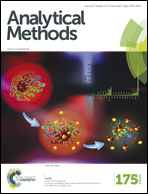Solid phase microextraction–comprehensive two-dimensional gas chromatography–time-of-flight mass spectrometry: a new tool for determining PAHs in airport runoff water samples†
Abstract
A fundamental aspect of airport operations is the pollution caused by airport runoff waters. Polycyclic aromatic hydrocarbons (PAHs) are one of the most important groups of xenobiotics which are commonly found in runoff water originating from airports. Only very limited data on the analysis of airport runoff water have been published until now. Therefore, a reliable and accurate analytical method based on headspace solid-phase microextraction (HS-SPME) coupled with comprehensive two-dimensional gas chromatography with time-of-flight mass spectrometry (GC × GC-TOF-MS) for simultaneous determination of 16 PAHs in airport runoff water was developed. The optimization of the HS-SPME procedure resulted in the following extraction conditions: extraction time of 45 min, temperature of 70 °C, salt addition of 3.0 g, and desorption time of 10 min at 270 °C. The recovery values obtained using this method (63–108%) mostly fell within the acceptable range for the analytical procedures. This indicates that HS-SPME is a suitable and efficient tool for the extraction of PAHs from airport wastewater, the latter being characterized by a very complex matrix composition. In addition, the developed procedure exhibited satisfactory selectivity, accuracy and a low MDL (0.22–2.20 ng L−1). It should be emphasized that the presented procedure is new with respect to the determination of toxic, mutagenic and carcinogenic analytes in the original environmental samples, elaboration of the detailed metrological characteristics, and the diversity of places from which runoff water samples are collected. The validated analytical protocol was successfully applied to determine the aforementioned organic pollutants in real samples collected from different international airports. Regardless of the airport location, chrysene, phenanthrene and pyrene were the most abundant PAH compounds detected in all analyzed samples (1.8–26.3 μg L−1). The presented methodology can be used for tracking the environmental fate of PAHs and assessing the impact of airports on the environment.



 Please wait while we load your content...
Please wait while we load your content...